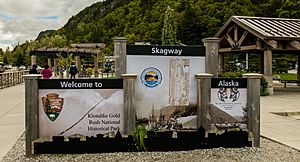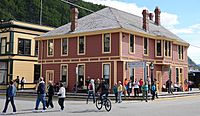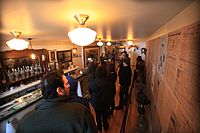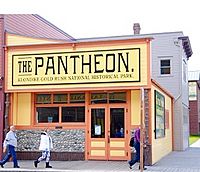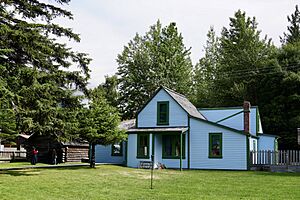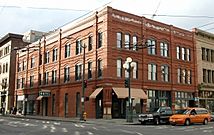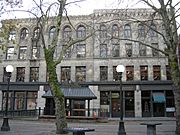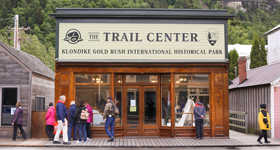Klondike Gold Rush National Historical Park facts for kids
Quick facts for kids Klondike Gold Rush National Historical Park |
|
|---|---|
|
IUCN Category III (Natural Monument)
|
|
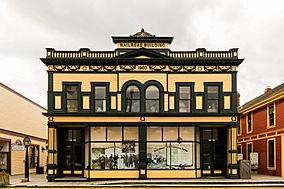
White Pass & Yukon Route Railway Administration Building serves as a museum
|
|
| Lua error in Module:Location_map at line 416: Malformed coordinates value. | |
| Location | Alaska and Washington, United States |
| Nearest city | Skagway, Alaska and Seattle, Washington |
| Area | 12,996 acres (52.59 km2) |
| Established | June 30, 1976 |
| Visitors | 860,048 (in 2011) |
| Governing body | National Park Service |
| Website | Klondike Gold Rush National Historical Park |
|
Klondike Goldrush National Historical Park
|
|
| Location | Union of Chilkoot Trail and Dyea Site and Skagway Historic District and White Pass |
| NRHP reference No. | 76002189 |
| Added to NRHP | June 30, 1976 |
The Klondike Gold Rush National Historical Park is a special place managed by the National Park Service. It helps us remember the exciting Klondike Gold Rush from the late 1890s. Even though the gold was found far away in Yukon, Canada, this park protects the places where people started their journey.
The park has four main parts. Three of these are in Skagway, Alaska, and one is in Pioneer Square in Seattle, Washington. To truly understand the gold rush story, you need to explore both sides of the Canada–United States border. Other historic sites in Canada, like those in Whitehorse and Dawson City, help complete the story.
In 1998, the Klondike Gold Rush National Historical Park joined with Canadian sites to form the Klondike Gold Rush International Historical Park. This allows visitors to experience the gold rush story across two countries.
Contents
Exploring Historic Skagway
The Skagway part of the park includes many old buildings in the downtown area. Some of these buildings are owned and restored by the National Park Service. Others are still used by businesses today, making the town feel as busy as it was during the gold rush!
You can start your visit at the park's Visitors Center. It's in the old railroad depot building at Second and Broadway. Here, you can join a ranger-led tour or explore on your own. Younger visitors can even earn their Junior Ranger badge at the Pantheon Saloon, further up Broadway.
- White Pass & Yukon Route Railway Broadway Depot. This building, finished in 1898, was the first train station for the railway. It now serves as the park's Visitors Center and main office. During World War II, the U.S. Army used it to help build the Alaska Highway. The building was restored in 1984 to look like it did between 1908 and 1915.
- White Pass & Yukon Route Railway Administration Building. This beautiful wooden building, completed in 1900, was once the railway's main office. Today, the bottom floor holds the park museum, and park offices are upstairs. It was also restored in 1984.
- Martin Itjen's House. This house, built in 1902, is now the Trail Center for both the National Park Service and Parks Canada. Martin Itjen bought it in 1922 and became famous for greeting tourists and selling tours. The house was moved and restored in 1991 to show how it looked from 1921 to 1941.
- Jeff. Smith's Parlor. This building was once used by a famous trickster named Jefferson "Soapy" Smith. He tried to trick miners for a few months before he was killed in Skagway. Martin Itjen later bought the saloon and turned it into a museum with moving figures. The building was given to the National Park Service in 2007 and reopened as a museum in 2016.
- Verbauwhede's Cigar Store. Frederick Verbauwhede opened a store selling cigars and sweets here in 1898. The building has been many things over the years, including a gunsmith and a gas station. It was restored in 1986, and the cigar store part is now leased to a private business.
- Boas Tailor & Furrier Shop. This shop once sold furs and had a tall, flat front, common in old western towns. After several other businesses, it was restored in 1986. Today, it is leased to a private business, helping Skagway feel like a busy town again.
- Pacific Clipper Line Office. This building first served the many steamship companies that brought people to Skagway. Later, it became a liquor store. After Skagway banned alcohol in 1916, it was used for other purposes. The park service acquired it in 1976 and now leases it to a private business.
- Mascot Saloon. Opened in 1898, this saloon was one of the few that stayed open after Skagway banned alcohol in 1916. It was later a drugstore. In 1976, it became part of the park and was restored to look like it did after the gold rush. It reopened as an exhibit in 1990.
- Lynch and Kennedy Dry Goods Store. This building was first built in 1900 as barracks for soldiers. It was moved and changed into a fancy clothing and fabric store in 1908. It closed by 1920 and was later a restaurant. The park service bought it in 1977 and restored it to its 1908-1915 look. It is now leased to a private business.
- Pantheon Saloon. This building was a hardware store in 1898 before becoming a saloon in 1903. It stayed open until Skagway banned alcohol in 1916. Now restored, the Pantheon invites young visitors to explore the park and earn their Junior Ranger badges.
- Moore Homestead. This was the very first home built in Skagway, even before the gold rush began.
- Peniel Mission. This building, once a Christian mission, now provides simple housing for the park's seasonal employees.
The White Pass Trail Adventure
The park also includes the famous White Pass Trail. This mountain path goes from Skagway all the way to the start of the Yukon River in British Columbia. It was one of two main routes gold seekers used to cross the mountains to reach the gold fields. The White Pass and Yukon Route railway, finished in 1900, followed this pass to take prospectors from Skagway to Whitehorse, Yukon.
Dyea Town and the Chilkoot Trail
The historic town of Dyea is another part of the park. From Dyea, the challenging Chilkoot Trail begins and stretches to Bennett Lake in British Columbia. From there, gold seekers usually built rafts to float down to Dawson City, Yukon.
The trail center in Skagway, run by both the National Park Service and Parks Canada, has important information about the Chilkoot Trail. You need a permit to hike this 33-mile (53-kilometer) trail, which crosses both countries.
Seattle's Role in the Gold Rush
The Pioneer Square Historic District in Seattle has several buildings from the 1880s and 1890s. The Cadillac Hotel, built in 1890, was a key place where gold seekers bought supplies and started their journey north. After being damaged in an earthquake in 2001, it was repaired and reopened in 2006. It now houses the park's visitor center and museum for the Seattle unit.
Other historic buildings in Seattle include the Pioneer Building (1892), Schwabacher Building (1890), Grand Central Hotel (1889), and Metropole Building (1895).
An International Gold Rush Park
In 1969, the United States and Canadian governments decided to create an international park for the Chilkoot Trail. The U.S. part became the Klondike Gold Rush National Historical Park in 1976. The Canadian part of the trail became the Chilkoot Trail National Historic Site.
Finally, in 1998, the dream of an international park came true. The Klondike Gold Rush National Historical Park and the Chilkoot Trail National Historic Site officially became the Klondike Gold Rush International Historical Park. This means the two park services work together to manage and share the gold rush story.
Other important Canadian sites are also part of this international effort. These include the Dawson Historical Complex National Historic Site in Dawson City, Yukon, and "The Thirty Mile" section of the Yukon River. This river section is recognized by both countries for its importance to the gold rush story.
Beyond the formal international park, there are other Canadian historic sites in Yukon that tell the gold rush story:
- Discovery Claim National Historic Site
- SS Keno National Historic Site
- Dredge No. 4 National Historic Site
- SS Klondike National Historic Site


